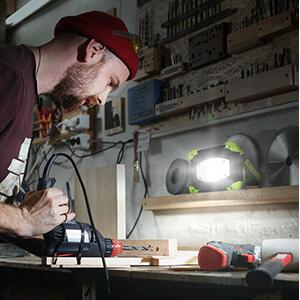High-quality workshop lighting is a must – something to be mindful of if your current workshop lighting is inadequate or you’re considering building a new one. Poor lighting, like glare and insufficient lighting, can lead to eyestrain and other vision issues. It can also result in low-quality work because the lack of sufficient lighting can affect tool setups and measurements (even with the best equipment being used). Bad workshop lighting may also contribute to workplace accidents.
And, if there are more reasons to use high-quality lighting in your workshop, think about the cost savings attributed to better light.
2 Primary Kinds of Lights in a Workshop
There are two critical types of workshop lighting:
- Ambient Lighting – This lighting is found in the entire building to illuminate the space. The key to a safe working environment using ambient lighting is to learn the basic rules of lighting and calculate the building space and size.
- Task Lighting – This lighting allows you to focus on a particular work area when visibility is a necessity to ensure accuracy and workers’ safety.
For example, if the shop is located in a garage or a shed, add windows and skylights to use the natural light to brighten the space.
Artificial lighting will still be necessary, especially on cloudy days or nighttime, but natural light can brighten the space and your mood. Once you’ve got the ambient lighting installed, it’s time to look at the kind of task lighting you need.
Consider Glare and Light Positions
- Bare incandescent bulbs will give your eyes light and reflect on the tabletop.
- Overhead light reflectors will protect your eyes but still create a glare on shiny surfaces.
- Lighting that’s high above and behind you will lighten up the surface and reduce glare.
Outfit Your Workshop with Ambient Lighting First
The first thing you need to worry about with your shop lighting is the ambient light, ensuring it’s more than adequate for the space you have. Most shops will do well with easily installable suspended fluorescent lighting with two four-foot tubes. However, other florescent lighting styles can work, along with incandescent fixtures. The key to any fixture is to ensure the reflectors point the light downward.
Special Tip: You can brighten the room, even more, by using a light color on the ceiling.
The best type of lights for a workshop that won’t consume a lot of energy are LED high bay lights. Yes, the cost for them is a bit more than the typical transformer magnetic ballast lights, but the energy savings more than makes up for it. The electronic ballast doesn’t make as much noise, eliminates the fluorescent flicker, and the tubes will start working immediately in the cold rooms. With the high bay lights, the fixtures have a longer lifespan and won’t show their age the older they get.
Make sure to set up the fixtures that ensure the light evenly falls around the workspace. Have ceiling fixtures installed behind you while you work at each particular station.
Since light reflects off surfaces at the same angle it hits, you want to place it away from reflecting on you, so there is no glare. Put light perpendicularly to the work surface length to reduce the glare too. Make sure lights are close together to reduce dark spaces between each fixture.
Have one light fixture at a particular height above the workspace. Turn off all the other lights to test that one to see how the light spreads. If light gets into your eyes, you’ll need to reposition them.
How Much Light Should Your Workshop Get?
How much light your workshop needs depends on the kind of work you’ll be doing. If precision is a must, you want to ensure you have plenty of light. Here’s a good idea of what your ambient lighting levels should be in your workspace.
- Large Space (High Contrast) – 300 to 500 lumens
- Small Space (Medium Contrast) – 750 to 1,000 lumens
- Extremely Small Space (Low Contrast) – 1,500 to 2,000 lumens
To ensure the right amount of light is installed, use the following steps:
- Measure the shop’s width and length, multiplying the length by the width to get the square footage area.
- Figure out what illumination level is necessary, but don’t forget you can also add task lighting to the space.
- Divide the square footage area by 10.76, which converts the total to square meters.
- Multiply the area using the square meters number by the preferred level of lighting in lux to find out how many lumens you will need.
- Divide this number by the lumens of the light source and round up to the following whole number. This will tell you how many tubes or bulbs will be necessary to get the amount of light you need.
Arrange Task Lighting Secondly
With task lighting, you can place the light where it’s needed. For example, you can use a portable work light (moving it from one place to another when necessary). You can also use a shop-built stand light to provide the task lighting you need. Another task light fixture that can work is a 250-watt halogen work lamp. Hang lamps with clamps can be hung from the ceiling if you’ll be working in a basement.
Use an LED shop light if you’ll be working at a workbench or carving station, positioning the light over the work. If you’re creating fine details, you can use the light to help you see better as you look through the magnifying lens. If you aren’t using a magnifying lens, you can use a swing-arm desk lamp. Whatever lamp you choose, you can clamp it to the surface or drill holes to keep it in place.






